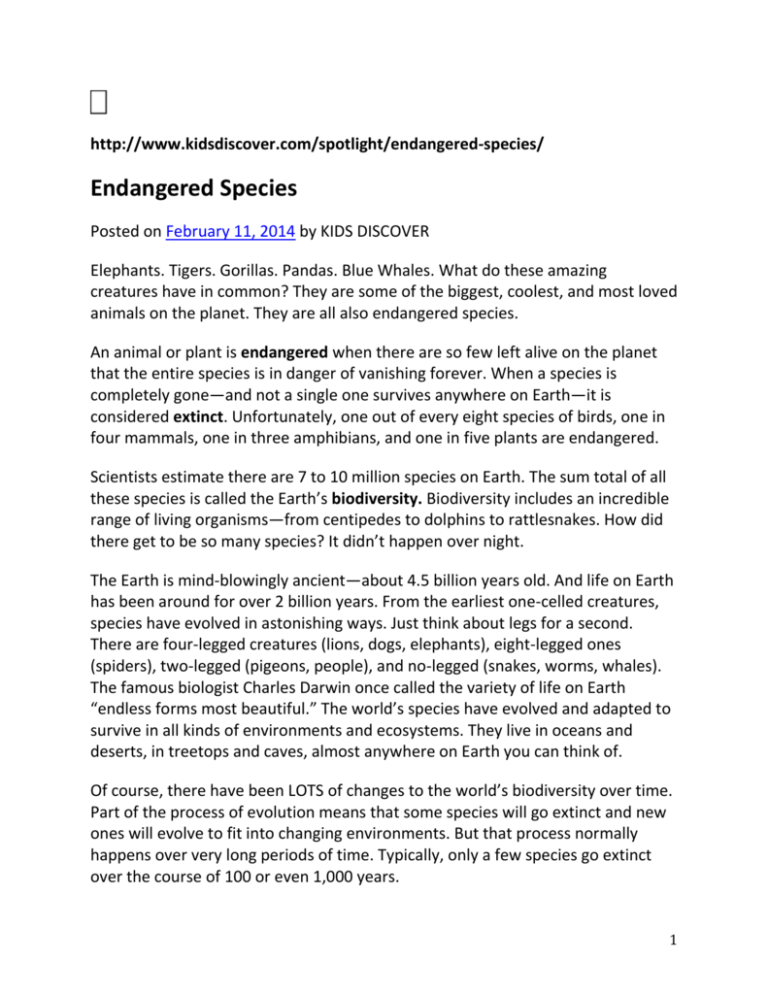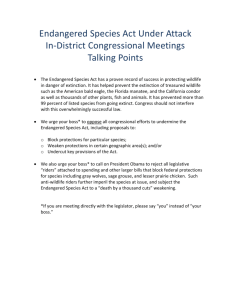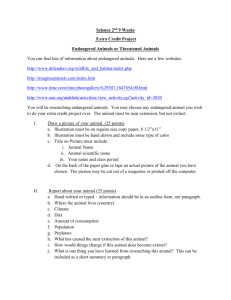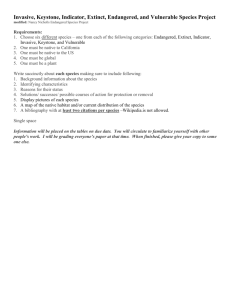Introducing invasive species.
advertisement

http://www.kidsdiscover.com/spotlight/endangered-species/ Endangered Species Posted on February 11, 2014 by KIDS DISCOVER Elephants. Tigers. Gorillas. Pandas. Blue Whales. What do these amazing creatures have in common? They are some of the biggest, coolest, and most loved animals on the planet. They are all also endangered species. An animal or plant is endangered when there are so few left alive on the planet that the entire species is in danger of vanishing forever. When a species is completely gone—and not a single one survives anywhere on Earth—it is considered extinct. Unfortunately, one out of every eight species of birds, one in four mammals, one in three amphibians, and one in five plants are endangered. Scientists estimate there are 7 to 10 million species on Earth. The sum total of all these species is called the Earth’s biodiversity. Biodiversity includes an incredible range of living organisms—from centipedes to dolphins to rattlesnakes. How did there get to be so many species? It didn’t happen over night. The Earth is mind-blowingly ancient—about 4.5 billion years old. And life on Earth has been around for over 2 billion years. From the earliest one-celled creatures, species have evolved in astonishing ways. Just think about legs for a second. There are four-legged creatures (lions, dogs, elephants), eight-legged ones (spiders), two-legged (pigeons, people), and no-legged (snakes, worms, whales). The famous biologist Charles Darwin once called the variety of life on Earth “endless forms most beautiful.” The world’s species have evolved and adapted to survive in all kinds of environments and ecosystems. They live in oceans and deserts, in treetops and caves, almost anywhere on Earth you can think of. Of course, there have been LOTS of changes to the world’s biodiversity over time. Part of the process of evolution means that some species will go extinct and new ones will evolve to fit into changing environments. But that process normally happens over very long periods of time. Typically, only a few species go extinct over the course of 100 or even 1,000 years. 1 However, during Earth’s history there have been some extreme events that have killed off large numbers of species. These events are called mass extinctions. One mass extinction you probably know about is the extinction of the dinosaurs. A catastrophic event—most likely a large asteroid slamming into Earth 65 million years ago—created such havoc that 75 percent of the world’s species went extinct. There have been five mass extinctions in the history of our planet. Unfortunately, if you look at the rate at which animals have been going extinct over the past 500 years and the growing number of species that have become and are becoming endangered, it looks like we are at the start of another mass extinction. In fact, some scientists call the time we live in the Sixth Extinction. What is the extreme event that is causing the Sixth Extinction? The answer is us: human beings. Most people love animals, but a lot of things we do as humans are not good for other species. Here is a list of the main reasons people cause other species to become endangered: –Destroying or damaging habitats –Overhunting, overfishing, and poaching –Introducing invasive species. –Polluting –Taking animals out of the wild for the exotic pet trade –Contributing to climate change By reversing these trends, we may be able to stop the Sixth Extinction. But it is not going to be easy. Habitat destruction is the biggest reason that species become endangered. One thing that’s important to remember is that species have evolved to live in particular habitats and ecosystems. Forest animals can’t survive in deserts. Fish can’t live out of water. And a freshwater fish can’t survive in salt water. When we take away or damage an animal’s habitat, it can’t just move somewhere else. 2 To save endangered species from extinction, their habitats must be protected. One way to protect important ecosystems is to create national parks, wildlife reserves, and marine protected areas. Yellowstone National Park in Wyoming, Montana, and Idaho is one of the largest relatively untouched habitats in the deciduous forests of the Northern Hemisphere. Yellowstone is home to endangered and threatened species including grizzly bears, lynx, and gray wolves. Around the world, over 12 percent of the Earth’s land area is under some form of protection. Many nations are now protecting ocean areas, too. The small Pacific island nation of Kiribati recently created the Phoenix Islands Protected Area which covers an ocean area the size of California—and is home to some of the world’s most biodiverse coral reef habitats. The Kerinci Seblat National Park in Indonesia is home to five volcanoes, rare tigers, elephants, rhinos, sun bears, flying foxes, and clouded leopards, as well as the corpse flower, the world’s largest (and worst-smelling) bloom. The young Malayan tapir shown here lives in a zoo, but wild tapirs are among the many endangered species that thrive in the protected forests of Kerinci Seblat. (Arun Noisri/ Shutterstock) Many species are now extinct because they were hunted until there were none left. One of the main threats the world’s five rhino species face is poaching. Even though it is illegal to kill rhinos, poachers hunt them for their horns—and they can sell the horns for lots of money because some people believe rhino horns can cure diseases. In fact, the horns are just made of keratin, the same stuff your hair, your fingernails, and horse hoofs are made from. The rhino horns won’t cure you of anything. So how do you protect rhinos? One way is having more wildlife police and another is developing crime-solving techniques to help catch poachers. Wildlife cops have made a rhino DNA database to help bust poachers. Another serious problem facing the world’s species is overfishing. Humans have been taking more fish out of the ocean for food than the seas can naturally produce. That means, compared to 200 years ago, there are a lot less fish in the sea. Today, about 1 in 20 fish species are endangered. One example is the bluefin tuna. The Atlantic bluefin tuna is slow to grow, but it can get big, as long as 10 feet, and weigh over 1,000 pounds. The problem for these fish is that about 50 years ago, people discovered they were delicious to eat and their population was 3 radically reduced by overfishing. Many countries now have rules about how many bluefin tuna can be caught. By reducing the total catch, the Atlantic bluefin tuna population may have a chance to recover. You would think that loving animals would help species survive. But sometimes wildlife can be “loved” into extinction. People who buy exotic pets are often unwittingly buying endangered animals that have been taken out of the wild. Parrots in particular have been hard hit by “love” from pet owners and the illegal pet trade. So many parrots have been taken out of the wild to live in private cages that some species are now extinct and others survive in very small numbers. The sale of endangered wildlife is outlawed in most places, but wildlife smugglers still grab tens of thousands of parrots, rare turtles, threatened tropical fish, and even tigers and primates, which can be sold illegally for thousands of dollars. Illegal poaching and wildlife trafficking are crimes. But other things people do that threaten wildlife can be accidental. For example, planes and boats can travel anywhere on the planet. Sometimes species that don’t belong hitch a ride and end up causing HUGE problems when they arrive in a new place. Such plants or animals are called invasive species. The brown tree snake is native to Australia and Indonesia, where it lives with natural checks and balances. On Guam—which until 60 years ago was a snakefree island—it is an out-of-control invasive species. No one knows exactly how the brown tree snake got to Guam, but a few probably slithered onto a boat and rode there across the ocean. Because none of Guam’s animals had ever seen a snake before, they were easy prey. Twelve species of birds, three lizards, and two bats are now completely gone from Guam, and more are endangered. To fight the invasive snakes, scientists are breeding two of the island’s rare birds in captivity in the hopes of reintroducing them to the wild one day. They’re also working to stop the brown tree snake from getting to other snake-free islands, such as a Hawaii. A crew of Jack Russell terriers is specially trained to sniff out snakes at Guam’s airport, so that none of them can sneak onto a plane. Although people are the cause of most of the problems facing endangered wildlife, we can also be part of the solution. Some species that were once on the brink of extinction are now thriving thanks to a helping hand from conservationists. 4 Written by Margaret Mittelbach 5








